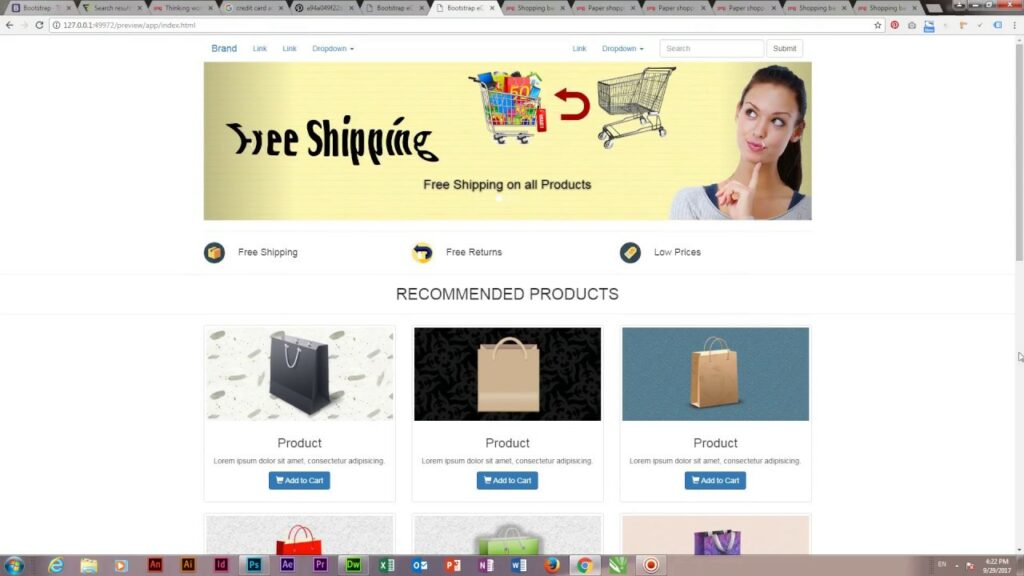Crafting Seamless E-commerce Experiences: A Comprehensive Guide to Implementing E-commerce Functionality in Adobe Dreamweaver

Introduction: E-commerce has become an integral part of modern business, enabling businesses to reach a global audience, sell products and services online, and drive revenue growth. Adobe Dreamweaver, a leading web development tool, offers powerful features and tools for implementing e-commerce functionality seamlessly into websites and web applications. In this extensive guide, we’ll explore the intricacies of implementing e-commerce functionality in Adobe Dreamweaver, covering various aspects such as product listings, shopping carts, payment gateways, and order processing to empower businesses to create compelling and effective online shopping experiences.
Understanding E-commerce Functionality: E-commerce functionality encompasses a range of features and capabilities that enable businesses to sell products and services online. Key components of e-commerce functionality include product catalog management, shopping cart functionality, secure payment processing, order management, and customer account management. Adobe Dreamweaver provides developers with tools and features to implement these e-commerce components effectively, leveraging technologies such as HTML, CSS, JavaScript, server-side scripting languages (e.g., PHP, ASP.NET), and integration with third-party e-commerce platforms and services.
Step 1: Planning Your E-commerce Website Before diving into implementation, it’s essential to plan your e-commerce website carefully. Consider the following factors when planning your e-commerce website in Adobe Dreamweaver:
- Define your product catalog: Identify the products or services you intend to sell online and organize them into categories and subcategories for easy navigation.
- Choose your e-commerce platform: Decide whether to build a custom e-commerce solution using Adobe Dreamweaver or leverage third-party e-commerce platforms such as WooCommerce, Shopify, Magento, or BigCommerce for faster deployment and extended functionality.
- Design user experience: Design the user interface and user experience of your e-commerce website, focusing on intuitive navigation, clear product presentation, streamlined checkout process, and responsive design for mobile devices.
- Plan payment processing: Choose a payment gateway provider and integrate secure payment processing functionality into your e-commerce website to accept credit card payments, PayPal, Apple Pay, and other payment methods securely.
Step 2: Building Product Listings and Catalogs Adobe Dreamweaver offers powerful features and tools for building and managing product listings and catalogs on e-commerce websites. Here’s how to build product listings and catalogs in Adobe Dreamweaver:
- Create product pages: Use Dreamweaver’s visual design tools to create product pages with detailed product descriptions, high-quality images, pricing information, and customer reviews.
- Implement product filters and search: Incorporate product filtering and search functionality into your e-commerce website to help users find products quickly and easily based on criteria such as category, price range, brand, and features.
- Manage product data dynamically: Use server-side scripting languages such as PHP or ASP.NET to retrieve product data dynamically from a database or external data source and populate product listings and catalogs dynamically.
Step 3: Implementing Shopping Cart Functionality Shopping cart functionality is essential for allowing users to add products to their cart, review their selections, and proceed to checkout securely. Here’s how to implement shopping cart functionality in Adobe Dreamweaver:
- Design the shopping cart interface: Design the layout and visual elements of the shopping cart interface using Dreamweaver’s visual design tools, incorporating features such as product thumbnails, quantity selectors, subtotal calculations, and remove buttons.
- Implement add-to-cart functionality: Use client-side scripting languages such as JavaScript to implement add-to-cart functionality, allowing users to add products to their cart without refreshing the page.
- Manage cart items: Use server-side scripting languages such as PHP or ASP.NET to manage cart items, update quantities, remove items, and calculate subtotal, tax, and shipping charges dynamically.
- Persist cart data: Implement mechanisms to persist cart data across sessions and page reloads, such as session cookies, local storage, or server-side sessions, to maintain the shopping cart state as users navigate the website.
Step 4: Integrating Payment Gateways Secure payment processing is a critical aspect of e-commerce functionality, ensuring that customer payment information is processed securely and transactions are completed smoothly. Here’s how to integrate payment gateways into your e-commerce website in Adobe Dreamweaver:
- Choose a payment gateway provider: Select a reputable payment gateway provider that supports secure payment processing and integrates seamlessly with Adobe Dreamweaver, such as PayPal, Stripe, Authorize.Net, or Square.
- Configure payment gateway settings: Configure the payment gateway settings in Dreamweaver, including API keys, merchant account credentials, and payment methods (e.g., credit card, PayPal).
- Implement payment processing logic: Use server-side scripting languages such as PHP or ASP.NET to implement payment processing logic, including form submission, validation, and communication with the payment gateway API to authorize and capture payments securely.
- Handle payment responses: Handle payment gateway responses asynchronously, processing payment confirmations, errors, and status updates to update order status, generate invoices, and send order confirmation emails to customers.
Step 5: Managing Orders and Customer Accounts Effective order management and customer account management are essential for providing a seamless and personalized shopping experience for customers. Here’s how to manage orders and customer accounts in Adobe Dreamweaver:
- Implement order management functionality: Use server-side scripting languages such as PHP or ASP.NET to implement order management functionality, including order processing, order tracking, order status updates, and order history for customers and administrators.
- Design customer account pages: Design user-friendly customer account pages where users can create accounts, sign in, view order history, update personal information, manage billing and shipping addresses, and track order status.
- Implement authentication and authorization: Implement authentication and authorization mechanisms to restrict access to customer account pages and order management functionality, ensuring that only authorized users can access sensitive information and perform account-related actions.
Step 6: Testing and Deployment Before deploying your e-commerce website to a production environment, it’s essential to thoroughly test its functionality, usability, and security. Here’s how to test and deploy your e-commerce website in Adobe Dreamweaver:
- Testing: Test your e-commerce website extensively on a local testing server to ensure functionality, usability, performance, and security. Conduct usability testing, accessibility testing, cross-browser testing, and performance testing to identify and address any issues or inconsistencies.
- Deployment: Once testing is complete, deploy your e-commerce website to a production server using Dreamweaver’s built-in FTP/SFTP support or external deployment tools. Configure server settings, domain settings, and SSL certificates to ensure secure and reliable deployment.
- Monitoring and maintenance: Continuously monitor your e-commerce website for performance issues, security vulnerabilities, and user feedback. Apply updates, patches, and optimizations as needed to ensure ongoing stability, security, and reliability.
Conclusion: Implementing e-commerce functionality in Adobe Dreamweaver empowers businesses to create compelling and effective online shopping experiences that drive sales and customer engagement. By following the steps outlined in this guide and leveraging Dreamweaver’s features and tools, you can build feature-rich, secure, and scalable e-commerce websites that meet the needs of modern consumers. Whether you’re a seasoned web developer or new to e-commerce development, mastering the art of e-commerce implementation in Dreamweaver opens up endless possibilities for creating innovative and impactful online shopping experiences.







